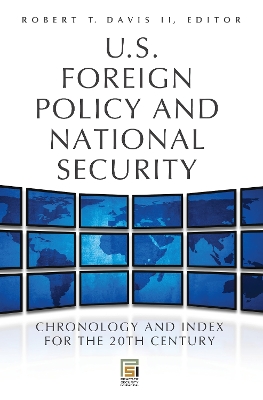Praeger Security International
3 total works
This comprehensive guide provides an in-depth, chronological overview of issues and policy processes related to U.S. foreign, military, and national security policy during the 20th century.
U.S. Foreign Policy and National Security: Chronology and Index for the 20th Century provides a unique compilation of data never before combined in a single volume. Key events and policy meetings are arranged in order by presidential administration, from the McKinley administration to that of President Obama. Each section begins with a concise list of policymakers, including Cabinet-level officials, members of the National Security Council, and senior ranks of the Department of State and Department of Defense, supplemented with bibliographic data.
The bulk of each chapter is comprised of detailed lists of meetings of the president of the United States with key advisors and foreign dignitaries. These meetings include international conferences, meetings between the president and foreign leaders, meetings of the joint chiefs of staff in World War II, and meetings of the National Security Council since its creation in 1947. This unprecedented guide will be invaluable to researchers and, indeed, to anyone interested in the decisions that determined the course of U.S. history.
- Includes lists of National Intelligence Estimates produced by the Central Intelligence Agency on the Soviet threat during the Cold War
- Provides unique tables of key policymakers one and two levels below Cabinet members
- Offers a comprehensive appendix containing brief biographical data of all the figures listed in the guide
- Includes numerous cross-references to the Department of State's Foreign Relations of the United States
What demographic, economic, and security-driven challenges does our global society face in an increasingly crowded and demanding environment? This two-volume set addresses this question through a comparative study of national approaches to grand strategy in world history.
Grand strategy in world history comprises the advancement of national policy goals through the coordinated, long-term application of diplomacy, economics, information management, and military power of a state. This standout comparative study opens with an overview of the development of the concept of grand strategy, followed by chapters categorized by key time periods: the Ancient World, the Age of Gunpowder, the Industrial Age, and the Modern Age. Written by expert contributors in their subject area, the chapters broadly examine national/cultural approaches to grand strategy, looking at the conduct of grand strategy over several decades.
The two-volume set addresses and answers questions such as: Are grand strategies best articulated by individuals or institutions? Are certain forms of institutionalization more effective than others at propagating grand strategy? Can grand strategies be transgenerational? Are certain types of polities more effective than others at developing and maintaining effective grand strategies? Have states tended to favor or excel at certain of the elements of national power over others? What is the optimum balance between diplomacy, economics, information management, and military power? Readers will come away with an appreciation for how any effective assessment of grand strategy requires much more than an appraisal of military power, and that a state's management of its financial and economic resources, its national morale, and its public diplomacy are key factors as well.
* Presents historical information across a relatively long chronological scale to enable readers to effectively make cross-cultural comparisons between nations and empires
* Includes maps outlining the rise and fall of states through time
* Provides relevant biographical sketches of "grand strategists" in world history
* Includes timelines of each age as well as an extensive bibliography for additional sources of information
![Cover of U.S. Foreign Policy and National Security [2 volumes]](https://images.bookhype.com/covers/d2/af/915751f3-d0c9-4a62-9618-a206be54fa2d/9780313383854-22c49d3cbd5093198dbaa9.jpg)
![Cover of Grand Strategy in Global History [2 volumes]](https://images.bookhype.com/covers/be/d1/915765f7-0ff9-47f6-9974-bd2015ca1deb/9780313398841-424a7f863ff5b6d31d4bfa.jpg)
